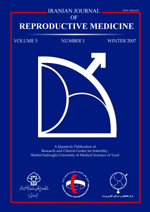
|
International Journal of Reproductive BioMedicine
Research and Clinical Center for Infertility, Shahid Sadoughi University of Medical Sciences of Yazd
ISSN: 1680-6433
EISSN: 1680-6433
Vol. 12, No. 1, 2014, pp. 19-28
|
 Bioline Code: rm14004
Bioline Code: rm14004
Full paper language: English
Document type: Research Article
Document available free of charge
|
|
|
International Journal of Reproductive BioMedicine, Vol. 12, No. 1, 2014, pp. 19-28
| en |
Association between increased expression of endothelial isoform of nitric oxide synthase in the human fallopian tube and tubal ectopic pregnancy
Bayati, Leyla Fath; Novin, Marefat Ghaffari; Fathabadi, Fatemeh Fadaei; Piryaei, Abbas; Heidari, Mohammad Hasan; Bandehpour, Mozhgan; Norouzian, Mohsen; Parhizgar, Mahdi Alizadeh & Fard, Mahmood Shakooriyan
Abstract
Background: Tubal ectopic pregnancy (tEP) is the most common type of extra-uterine pregnancy and the most common cause of maternal mortality. Nitric oxide (NO) is a molecule that incorporates in many physiological processes of female reproductive system. Recent studies have demonstrated the possible role of endothelial isoform of nitric oxide synthase (eNOS) enzyme in the regulation of many reproductive events that occur in the fallopian tube (FT).
Objective: The aim of this study was to evaluate the expression of eNOS in the FTs of women with tEP.
Materials and Methods: In this case-control study, a total number of 30FTs samples were obtained from three groups including: 10 FTs of women that bearing an EP, 10 FTs from the non-pregnant women at luteal phase of the menstrual cycle, and 10 FTs of healthy pregnant women (n=10). Samples were fixed in 10% buffered formalin and then were evaluated by immunohistochemistry.
Results: Localization of eNOS was seen in secretory and ciliated luminal epithelium and vascular endothelium of all groups. However, we did not observed the expression of eNOS in smooth muscle cells of all groups. Expression of eNOS in luminal epithelium of women with EP compared to non-pregnant women at luteal phase of menstrual cycle and healthy pregnant group showed statistically significant increase (p=0.00). Significant difference in expression of eNOS was not observed in luminal epithelium of FTs of women at luteal phase compared to healthy pregnant groups (p=0.78).
Conclusion: This study indicates that changes in expression of eNOS in luminal epithelium of FT may lead to development of EP.
Keywords
Ectopic pregnancy; Nitric oxide; Immunohistochemistry; Fallopian tube
|
| |
© Copyright 2014 - Iranian Journal of Reproductive Medicine
Alternative site location: http://www.ijrm.ir
|
|
